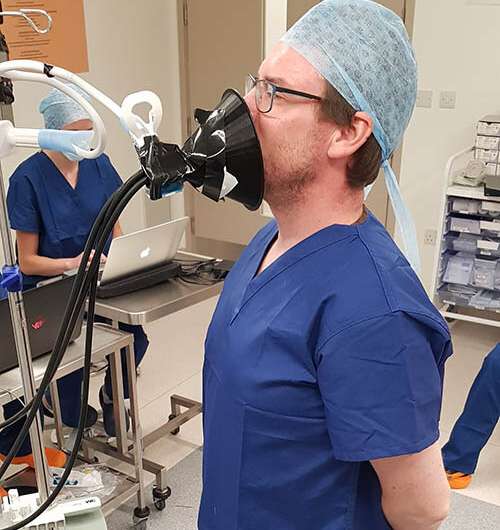Singing is no more risky than talking, finds new COVID-19 study

The performing arts has been badly affected during the coronavirus pandemic with live musical performances canceled for many months because singing was identified as a potential "higher risk" activity. New collaborative research has shown that singing does not produce very substantially more respiratory particles than when speaking at a similar volume. The findings, published on the pre-print server ChemRxiv, are crucial in providing COVID-19 guidance for live musical performances and the safe distancing of performers and audience.
The research project, known as PERFORM (ParticulatE Respiratory Matter to InForm Guidance for the Safe Distancing of PerfOrmeRs in a COVID-19 PandeMic), was supported by Public Health England and the Department for Digital, Culture, Media and Sport (DCMS), and carried out by a collaborative team from Imperial College London, University of Bristol, Wexham Park Hospital, Lewisham and Greenwich NHS Trust and Royal Brompton Hospital.
This is the first study to look at the amounts of aerosols and droplets (up to 20 µm diameter) generated by a large group of 25 professional performers completing a range of exercises including breathing, speaking, coughing, and singing. The experiments included the same individuals singing and speaking "Happy Birthday' between the decibel (dB) ranges of 50–60, 70-80 and 90-100 dB.
Although a number of studies reported online have attempted to examine the quantities of particulate matter expelled by performers, they have struggled to correctly quantify the aerosol and droplets because of the large number of ambient particles in the environment, making it impossible to identify which particles come from the performer and which are just already present in the space. Carrying out measurements in an orthopedic operating theater, an environment of "zero aerosol background," has allowed the team to unambiguously identify the aerosols produced from specific vocalizations.
The researchers discovered that there is a steep rise in aerosol mass with increase in the loudness of the singing and speaking, rising by as much as a factor of 20-30. However, singing does not produce very substantially more aerosol than speaking at a similar volume.
There were no significant differences in aerosol production between genders or among different genres (choral, musical theater, opera, choral, jazz, gospel, rock and pop).
Musical organizations could consider treating speaking and singing equally, with more attention focused on the volume at which the vocalization occurs, the number of participants (source strength), the type of room in which the activity occurs (i.e. air exchange rate) and the duration of the rehearsal and period over which performers are vocalizing. Indeed, based on the differences observed between vocalization and breathing and the likely difference in the number of performers and audience members in many venues, singers may not be responsible for the greatest production of aerosol during a performance and ways to ensure adequate ventilation in the venue may be more important than restricting a specific activity.
These recommendations will add to the research that can move towards allowing live musical performances and the safe distancing of performers and the audience, during the COVID-19 pandemic.
Jonathan Reid, Director of ESPRC Center for Doctoral Training in Aerosol Science and Professor of Physical Chemistry in the School of Chemistry at the University of Bristol and a corresponding author on the paper, said: "The study has shown the transmission of viruses in small aerosol particles generated when someone sings or speaks are equally possible with both activities generating similar numbers of particles. Our research has provided a rigorous scientific basis for COVID-19 recommendations for arts venues to operate safely for both the performers and audience by ensuring that spaces are appropriately ventilated to reduce the risk of airborne transmission."
Culture Secretary Oliver Dowden said: "Singing and playing music are passions for many people who will welcome the findings of this important study, which shows that there are no heightened risks associated with these activities. This means people can get back to performing, another important step showing we are Here for Culture through COVID. We have worked closely with medical experts throughout this crisis to develop our understanding of the virus, and our guidance is updated in light of these findings today."
Declan Costello, a consultant ear, nose and throat surgeon specializing in voice disorders at Wexham Park Hospital, and corresponding author on the paper, added: "This research will give useful information to performers, venues and arts organizations about how they can reintroduce singing performances."
More information: Gregson et al., Comparing the Respirable Aerosol Concentrations and Particle Size Distributions Generated by Singing, Speaking and Breathing. (2020). doi.org/10.26434/chemrxiv.12789221.v1




















